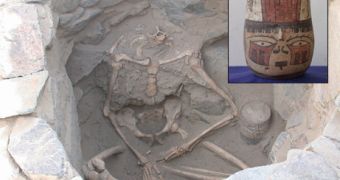Being light-headed was brought to the extremes by ancient Peruvians.
A decapitated skeleton discovered in a tomb of Nasca, the ancient civilization that bloomed in southern Peru from A.D. 1 till 750, offers more explanations about this civilization of head hunters.
People belonging to this civilization are famous for being the authors of the giant "Nasca lines" in the earth that depict figures only visible from the sky and for practicing human sacrifices and their modified trophy human heads. Still, the researchers debate whether the trophies came from war enemies or Nasca people sacrificed in rituals.
The skeleton was found in 2004 in La Tiza site by Christina Conlee, an archaeologist at Texas State University and the body was located cross-legged with a ceramic "head jar" on the left of his body.
"The age and condition of both the body and the jar, which is painted with two inverted human faces, suggests that the victim was killed in a rite of ancestral worship. This research is important because it provides new information on human sacrifice in the ancient Andes and in particular on decapitation and trophy heads," said Conlee.
"The skeleton appears to belong to a 20- to 25-year-old male and bears gruesome evidence of the decapitation, including cut marks indicating that the bone was fresh when damaged. Someone spent quite a bit of effort cutting off the head, mostly likely with a sharp obsidian knife," Conlee noted.
This is the third known Nasca head jar encountered with a decapitated body. Head jars discovered at other Nasca sites were linked with high-status burials, but it is just speculation. The new skeleton belongs to the Middle Nasca period, 450 to 550 A.D., but the artifacts were typical for the Early Nasca period, 1 to 450 A.D.
"This placement suggests that the killing was an act of ancestral worship and that the sacrifice was meant to honor the forebears buried in the cemetery. This man may have been sacrificed in order to appease the ancestors of the community and therefore ensure continuation of life at the villages," she explained.
The head jar is painted with the reversible image of a human face that can be watched right-side up or upside down, thus the jar could have been a substitute for the victim's missing real head.
"The La Tiza head jar was a rather literal replacement and reflects the Nasca belief that a person needed to have a head when he entered the afterlife," Conlee said.
"Decorations on head jars suggest they were used for both human- and crop-fertility rituals. Head jars often have images of plants growing out of them, suggesting a direct link to agriculture fertility, as well as a desire to continue the fertility of the people in the community," she added.
Still, others believe the discovery belongs to a war casualty.
"One alternative explanation is that this might simply have been someone who had been killed and decapitated in a raid and whose body subsequently was recovered by relatives who gave it a proper burial, with a ceramic vessel replacing his lost head," held out John Verano, an expert in Nasca culture and archaeologist from Tulane University.

 14 DAY TRIAL //
14 DAY TRIAL //